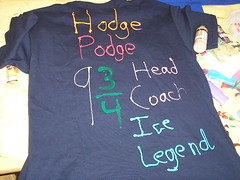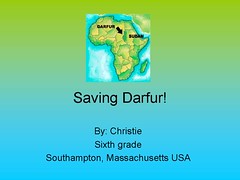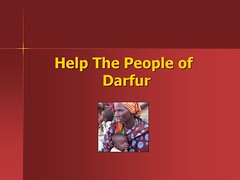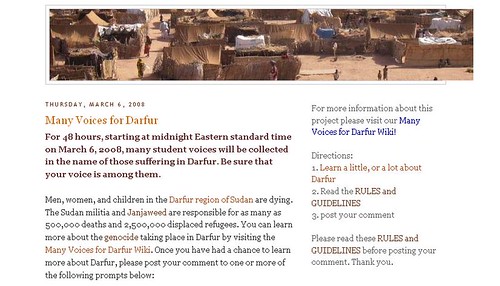 A few weeks ago, I began following the progress of a project to get young people to have a voice in the genocide taking place in Darfur. Called Many Voices for Darfur, it is spearheaded by by DC 8th grade teacher George Mayo and Tampa 3rd grade teacher Wendy Drexler, and their intent is to use a blog to connect as many young people as possible over a 48 hour period (next Thurs and Fri) to write about why the world should step in and stop the violence in that region of the Sudan.
A few weeks ago, I began following the progress of a project to get young people to have a voice in the genocide taking place in Darfur. Called Many Voices for Darfur, it is spearheaded by by DC 8th grade teacher George Mayo and Tampa 3rd grade teacher Wendy Drexler, and their intent is to use a blog to connect as many young people as possible over a 48 hour period (next Thurs and Fri) to write about why the world should step in and stop the violence in that region of the Sudan.
This week, I took the plunge and decided that a unit on persuasive writing that I am doing with my students was just too good an opportunity to pass up and that the Darfur situation — while no doubt tricky to discuss with 11 year olds — will give them some insight into the world beyond their suburban homes. I am not sure how it will all go, to be honest. Tomorrow, I am going to use an online scavenger hunt that someone developed to gather some information about the situation and show part of an online video showcasing the history of the situation and what the world is doing, or not doing, as hundreds of thousands are dying.
 Next week, we’ll begin writing our persuasive pieces, from a couple possible angles. I am running into the difficulty of timing our work, and access to computers, with the 48-hour window of opportunity. And I just realized that the Friday is a half-day for us with the students (the other half: professional development). I would love to podcast my students reading their pieces, too, but am unsure if I can pull that off.
Next week, we’ll begin writing our persuasive pieces, from a couple possible angles. I am running into the difficulty of timing our work, and access to computers, with the 48-hour window of opportunity. And I just realized that the Friday is a half-day for us with the students (the other half: professional development). I would love to podcast my students reading their pieces, too, but am unsure if I can pull that off.
My principal is fully on board and loves the idea. I sent an email home to parents today, alerting them to the project. The kids were silent and thoughtful as I introduced a bit of what we were going to be doing and some asked if what was going on in Darfur was like what happened in Germany under Hitler. They were already making some connections that will allow me to frame their understanding in some interesting ways.
I know they are looking for as many teachers and as many students as possible, so head to the blog site or the wiki planning site and get involved. When we talk about Web 2.0 and the power to put meaningful writing and social action in the hands of our students, this is the kind of project we are all talking about and advocating. It can be as simple as a blog post, or a petition, or a podcast, or a video. You decide.
I found this video from the band Mettafix that is interesting. It’s a great song:
[kml_flashembed movie="http://www.youtube.com/v/qQwCCm-H-sU" width="425" height="350" wmode="transparent" /]
The first stanza:
See the nation through the people’s eyes,
See tears that flow like rivers from the skies.
Where it seems there are only borderlines
Where others turn and sigh,
You shall rise (x2)
Peace (it’s the least we can do),
Kevin










 A few weeks ago, I began following the progress of a project to get young people to have a voice in the genocide taking place in Darfur. Called
A few weeks ago, I began following the progress of a project to get young people to have a voice in the genocide taking place in Darfur. Called  Next week, we’ll begin writing our persuasive pieces, from a couple possible angles. I am running into the difficulty of timing our work, and access to computers, with the 48-hour window of opportunity. And I just realized that the Friday is a half-day for us with the students (the other half: professional development). I would love to podcast my students reading their pieces, too, but am unsure if I can pull that off.
Next week, we’ll begin writing our persuasive pieces, from a couple possible angles. I am running into the difficulty of timing our work, and access to computers, with the 48-hour window of opportunity. And I just realized that the Friday is a half-day for us with the students (the other half: professional development). I would love to podcast my students reading their pieces, too, but am unsure if I can pull that off.